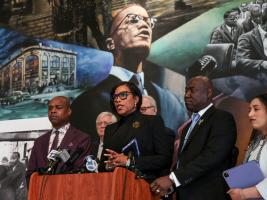Whether Super Bowl quarterbacks, or presidents, or police chiefs, unquestioned admiration of the "first Black" should come to an end.
When the National Football League (NFL) has its championship game this Sunday, what most of us commonly call the Super Bowl, one of the story lines will be that this will be the first time both teams will feature a Black starting quarterback. Patrick Mahomes, likely on his way to his second league MVP award and widely considered the best QB of any race in the league, will start for Kansas City. Jalen Hurts, one of the league's most improved players, will start for Philadelphia.
While the occurrence will be historical, I get a sense of déja vu when the NFL attempts to pat itself on the back for all the progress it made for the Black QB. I’m reminded of the first super bowl with two Black head coaches after the 2006 season between Chicago’s Lovie Smith and Indianapolis’s Tony Dungy. The event was held up as some breakthrough for Black coaches and surely there would be more opportunities to come right?
Wrong!
Over 15 years later, former Miami head coach Brian Flores has a pending lawsuit against the NFL for racial discrimination in its hiring practices of coaches. In spite of inserting a rule requiring the interviewing of “a person of color,” commonly called the Rooney Rule, about 20 years ago, there are 4 white head coaches hired for every 1 Black head coach. This from a league composed of about 70% Black players.
Sports is of course a microcosm of the larger society on this issue. Lack of opportunity is not new. Nor is the all too common knee jerk celebratory reaction to “first Black symbolism,” be it in sports and certainly beyond.
Memphis police Chief Cerelyn “CJ” Davis was the first Black woman to hold that position in the same city where Martin Luther King was murdered. And yet for all of its symbolic meaning, her appointment did absolutely nothing to prevent the murder of Tyree Nichols. In fact, not only was Davis a supporter of the so-called “Scorpion” unit of cops that killed Nichols, she formed a similar unit in Durham, North Carolina where she was previously chief of police. She oversaw a similar unit while she was a major in the Atlanta Police department. It was eventually disbanded due to the number of complaints by the public about tactics similar to those of the Scorpion unit in Memphis. One of its members insisted Atlanta brass knew they were using. Given that, it is not a stretch to say that Davis is as culpable as the cops that literally beat Nichols to death.
New York Congressman Gregory Meeks was the first Black member to chair the powerful Foreign Affairs committee when Democrats were in the majority. Yet he sponsored a bill called The Countering Malign Russian Activities in Africa Act which passed by a vote of 419-9. Every member of the Congressional Black Caucus voted for this bill which purports to punish any African country that aligns with Russia.
Michael Langley is the first Black 4-star general in the Marine Corps and has now been named the head of the US Africa Command, AFRICOM. But there has been no letup in the bombing and civilian casualties on the continent carried out under the guise of anti-terrorism, especially in the Horn of Africa. In fact, with little to no corporate media attention, the Southwest Missouri National Guard unit was just deployed to the continent.
The first Black symbolism is worse than an empty gesture. It is actually dangerous in that it often serves as a “Trojan Horse” able to advance Neoliberal policies at home and imperialist machinations abroad under the cover of a Black face as the leader.
I am not suggesting that all that is symbolism is without substance. Even within sports, at Mexico City in the 1968 Olympics, track stars John Carlos and Tommie Smith raised their fists on the winner’s podium symbolizing Black Power. The substance of the moment was that it reflected an evolutionary period of the movement from civil rights to human rights, from limited tactics to unlimited tactics, from domestic to international focus in the struggle for Black liberation. Likewise, former NFL QB Colin Kaepernick’s symbolic kneeling was of substance in that it forced millions into a conversation about police terrorism that many preferred to ignore.
We must be able to identify empty symbolic gestures with underlying counterproductive outcomes. One example would be the DC Mayor Muriel Bowser painting Black Lives Matter on a street while increasing the budget of the police department.
Wes Moore was recently elected the first Black Governor in the state of Maryland. Many are optimistic about this development. I am not! We have seen this story before in the track record of Barack Obama, whom all too many Black folks still consider to be a messiah and for whom it is blasphemy to offer any critical analysis of his impact on Black America.
The killing of Tyree Nichols by mostly Black cops should teach us once and for all that the number of Black faces installed in anti-Black and Imperialistic places will not shield us from the same outcomes. In fact, the case can be made that showing a capacity to mimic the oppressive behaviors of the masters is a rite of passage and only those who have proven themselves able and willing are ever allowed to ascend to such positions in the first place. The mission before us is to get beyond the excitement over “first black symbolism” and embrace liberation substance.
Gus Griffin is a DC area based independent sportswriter, a member of the Black Alliance for Peace Africa Team and the Ujima People’s Progress Party.



















